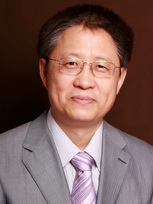
ZHU, Ben-Zhan (Benny)
Research Center for Eco-Environmental Sciences, Chinese Academy of Sciences
Email: bzhu@rcees.ac.cn
Address: Beijing city Haidian District Shuangqing Road No. 18
Research Areas
Education
PhD. (1999) Biochemistry, Hebrew University-Hadassah Medical School (Jerusalem, Israel)
MSc. (1989) Organic Chemistry, Lanzhou Institute of Chemical Physics, Chinese Academy of Sciences (CAS) (Lanzhou, China)
Experience
Work Experience
2006-present, Professor, Research Center for Eco-Environmental Sciences, CAS
2006-present, Affiliated Faculty Member, Linus Pauling Institute, Oregon State University
2002-2006, Assistant Professor (Sr. Res.) and Principal Investigator, Linus Pauling Institute, Oregon State University
1999-2002, Faculty Research Associate, Linus Pauling Institute, Oregon State University
1992-1993, Visiting Scholar, Hebrew University-Hadassah Medical School, Israel
1989-1995, Lecturer, Qingdao University Medical School
Teaching Experience
Free radical chemistry and biology
Publications
Papers
- Zhu B.Z., Chao X.J., Huang C.H., Li Y. (2016) Delivering the cell-impermeable DNA ‘light-switch’ Ru(II) complexes preferentially into live-cell nucleus via an unprecedented ion-pairing method. Chem. Sci 7:4016-4023 (Cover story)
- Mao, L., Huang, C.H., Gao, H.Y., Kalyanaraman, B., Zhu, B.Z. (2015) Intrinsic chemiluminescence generation during advanced oxidation of persistent halogenated aromatic carcinogens. Environ. Sci. Technol. 49: 7940-7947.
- Huang, C.H.; Ren, F.R.; Shan, G.Q.; Qin, H.; Mao, L.; Zhu, B.Z. (2015) Molecular mechanism of metal-independent decomposition of organic hydroperoxides by the halogenated quinoid carcinogens and the potential biological implications. Chem. Res. Toxicol., 28, 831-837. (Cover story)
- Zhu B.Z., Hollenberg PF (2015) Chemical toxicology in China: A special issue. Chem. Res. Toxicol. 28: 279-280. (Guest Editor’s Editorial)
- Shan GQ, Yu A, Zhao QF, Huang CH, Zhu LY, Zhu B.Z. (2015) A combined experimental and computational investigation on the unusual molecular mechanism of Lossen rearrangement reaction activated by the carcinogenic halogenated quinones. J. Org. Chem. 80: 180-189.
- Li Y, Huang CH, Liu YX, Mao L, Zhu B.Z. (2014) Detoxifying polyhalogenated catechols through a copper-chelating agent by forming stable and redox-inactive hydrogen-bonded complexes with an unusual perpendicular structure Chemistry-A European Journal, 20(40):13028-33
- Huang, C. H.; Shan, G. Q.; Mao, L.; Kalyanaraman, B.; Qin, H.; Ren, F. R.; Zhu, B. Z. (2013) The first purification and unequivocal characterization of the radical form of the carbon-centered quinone ketoxy radical adduct. Chem. Commun. 49: 6436-6438
- Qin H, Huang CH, Mao L, Xia HY, Kalyanaraman B, Shao J, Shan GQ, Zhu BZ. (2013) Molecular mechanism of metal-independent decomposition of lipid hydroperoxide 13-HPODE by halogenated quinoid carcinogens. Free Radic. Biol. Med. 63,459-466
- Shao J, Huang CH, Kalyanaraman B, Zhu B.Z. (2013) Potent methyl oxidation of 5-methyl-2’-deoxycytidine by halogenated quinoid carcinogens and hydrogen peroxide via a metal-independent mechanism. Free Radic. Biol. Med. 60, 177-182
- Zhu B.Z., Mao L., Huang C.H., Qin H., Fan R.M., Kalyanaraman B., Zhu J.G. (2012) Unprecedented hydroxyl radical-dependent two-step chemiluminescence production by polyhalogenated quinoid carcinogens and H2O2. Proc. Natl. Acad. Sci. USA 109: 16046-16051.
- Sheng Z.G., Zhu B.Z. (2011) Low Concentrations of Bisphenol A Induce Mouse Spermatogonial Cell Proliferation by G-Protein-Coupled Receptor 30 and Estrogen Receptor-α. Environ. Health Perspect. 119: 1775-1780.
- Zhu B.Z., Zhu J.G., Kalyanaraman B., Mao L. and Shan G.Q. (2010) Detoxifying polyhalogenated quinones by hydroxamic acids via an unusual double Lossen rearrangement. Proc. Natl. Acad. Sci. USA 107: 20286-20290.
- Zhu B.Z., Shan G.Q., Huang C.H. and Kalyanaraman B. (2009) Metal-independent decomposition of hydroperoxides by halogenated quinones: Detection and identification of a quinone ketoxy radical. Proc. Natl. Acad. Sci. USA 106: 11466-11471.
- Zhu B.Z., Kalyanaraman B. and Jiang G.B. (2007) Molecular Mechanism for metal-independent production of hydroxyl radicals by hydrogen peroxide and halogenated quinones. Proc. Natl. Acad. Sci. USA 104: 17575-17578.
- Zhu B.Z., Zhao H.T., Kalyanaraman B. Liu J., Shan G.Q., Du Y.G. and Frei B. (2007) Mechanism of metal-independent decomposition of organic hydroperoxides and formation of alkoxyl radicals by halogenated quinones. Proc. Natl. Acad. Sci. USA 104: 3698-3702.
Students
已指导学生
单国强 01 19367
范瑞梅 01 19367
朱俊歌 01 19367
毛莉 01 19367
覃浩 01 19367
夏海英 01 19367
刘玉祥 01 19367
李岩 01 19367
任福荣 01 19367
黄春华 01 19367
邵波 01 19367
高慧颖 01 19367
巢细娟 01 19367
现指导学生
沈忱 01 19367
李锋 01 19367
谢琳娜 01 19132
严诸颖 01 19132
黄蓉 01 19367
徐丹 01 19132
肖璇 02 67011
秦丽 01 19367
唐苗 01 19132
唐天舒 02 63224
李培林 02 67011
Honors & Distinctions
2013 “Outstanding Science & Technology Achievement Prize of the CAS” (as one of the three outstanding contributors)
